油气储运专业英语
油气储运专业英语reading部分翻译

Petroleum and Its Modern Uses[1] Petroleum, coal, and natural gas are the most widely used sources of energy in the m odern world. They are of primary importance in the industrialized countries, where vast am ounts of energy are consumed to operate the different kinds of machines used today. The se three energy sources are collectively referred to as fossil fuels.石油、煤炭和天然气是现代世界最广泛使用的能源。
它们在工业化国家中最为重要,在这些国家,人们消耗大量的能源来操作今天使用的各种机器。
这三种能源统称为化石燃料。
[2] At various depths beneath land and sea, there are accumulations of hydrocarbons form ed millions and even hundreds of millions of years ago by decomposition of animal and v egetable remains. They were covered by sand or mud, which in time was itself covered by the water of the seas. Hydrocarbons are compounds of hydrogen and carbon which, at n ormal temperatures and pressures, may be gaseous, liquid or solid according to their mole cular complexity. The natural deposits are correspondingly gaseous, liquid or solid, dependi ng on the relative proportion of the various hydrocarbons present in mixture. Petroleum is composed largely of the remains of these tiny marine animals and plants that lived so lo ng ago.在陆地和海洋的不同深处,有数百万年甚至数亿年前由于动物和植物残骸的分解而形成的碳氢化合物的积聚。
(完整版)油气储运专业英语(英汉互译)
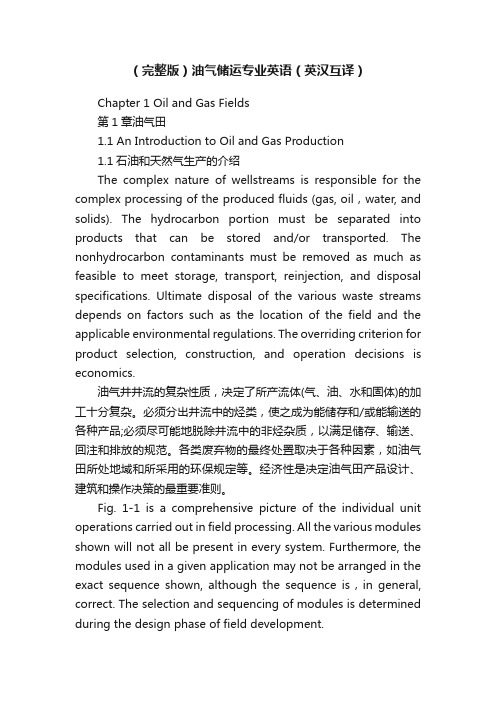
(完整版)油气储运专业英语(英汉互译)Chapter 1 Oil and Gas Fields第1章油气田1.1 An Introduction to Oil and Gas Production1.1石油和天然气生产的介绍The complex nature of wellstreams is responsible for the complex processing of the produced fluids (gas, oil,water, and solids). The hydrocarbon portion must be separated into products that can be stored and/or transported. The nonhydrocarbon contaminants must be removed as much as feasible to meet storage, transport, reinjection, and disposal specifications. Ultimate disposal of the various waste streams depends on factors such as the location of the field and the applicable environmental regulations. The overriding criterion for product selection, construction, and operation decisions is economics.油气井井流的复杂性质,决定了所产流体(气、油、水和固体)的加工十分复杂。
必须分出井流中的烃类,使之成为能储存和/或能输送的各种产品;必须尽可能地脱除井流中的非烃杂质,以满足储存、输送、回注和排放的规范。
【论文】油气储运工程论文油气储运工程论文

【关键字】论文油气储运工程论文油气储运工程论文油气储运工程专业课程模块化设置研究摘要:针对油气储运工程专业旧有的专业课程设置及教学内容存在的问题,提出了该专业课程模块化设置的构想,根据油气储运工程专业特点将专业课程划分为油品输送和储存技术、天然气输送和储存技术和专业通用技术三大模块,以此为根底构成完整的课程体系框架。
本文内容是对油气储运工程专业课程设置改革的一点探讨,起到抛砖引玉的作用。
关键词:油气储运工程课程体系模块化一、油气储运工程专业概况及专业特点油气储运工程专业的培养目标是培养具备工程流体力学、物理化学、油气储运工程等方面知识,能在国家与省、市的发展计划部门、交通运输规划与设计部门、油气储运与销售管理部门等从事油气储运工程的规划、勘查设计、施工项目管理和研究、开发等工作,适应社会主义现代化建设需要,全面掌握油气储运工程领域各方面知识,具有开拓、创新精神、较强的动手能力和协调能力的高级工程技术人才。
油气储运顾名思义就是油和气的储存与运输,从油气储运工程的主要任务可以归纳得出:油气储运工程专业方向可以划分为两大方向,即油品(包括原油和成品油)输送和储存技术、天然气输送和储存技术。
由于石油产品和天然气其物性参数有其共性又有其各自的特性,因此造成油气储运工程两大专业方向有共通处,又有其各个方向的独立性,两者即独立又有机的结合,这就是油气储运工程专业其独有的专业特色。
二、国内油气储运工程专业课程设置调研我国的油气储运工程学科是从20世纪四、五十年代起借鉴前苏联的办学经验而建立起来的[1]。
近二十年来,随着我国油气储运业的兴旺发展,对从事油气储运工作的专业技术人才的需求也不断增大,我国开办油气储运专业的大学已从原来的两所增加到20多所。
其中具有代表性的大学除了江苏工业学院外,主要还有:石油大学、西南石油大学、辽宁石油化工大学和后勤工程学院。
笔者调研了这几所高校的油气储运工程专业课程的设置情况,有如下认识:总体上各高校的油气储运工程专业课程设置架构大体相同,都兼顾了油和气两个方向,开设的专业课程主要有:油气集输工程、油库设计与管理、专业英语、储运防腐技术、泵与压缩机、油料学、储运仪表自动化、城市配气、管罐强度设计、油气管道输送、储运焊接和施工等。
0专业代码

专业代码、名称及研究方向人数考试科目备注001 地球科学学院070704 海洋地质01海洋沉积学02大陆边缘构造03海洋油气地质3①101政治②201英语一或202俄语③302数学二④801地质学综合或802石油地质学综合同等学力加试科目:造岩矿物学、岩浆岩与变质岩石学。
070900 地质学(包括070901 矿物学、岩石学、矿床学;070902 地球化学;070903 古生物学与地层学;070904 构造地质学)01应用矿物岩石学及测试技术02沉积(岩石)学及储层地质学03层序地层学及测井地质学04油气成因机理与分布预测05有机地球化学06环境地球化学07区域构造与盆地演化08油区构造解析09构造变形过程与动力学机理10应用古生物学及现代地层学70101政治②201英语一或202俄语③302数学二或807构造地质学或808沉积岩石学或809有机地球化学④801地质学综合同等学力加试科目从造岩矿物学、岩浆岩与变质岩石学、古生物学与地史学中任选2门。
077501 环境科学01城市大气环境02环境地质与环境地球化学03能源与环境04环境分析技术与评价10①101政治②201英语一③302数学二④803环境学概论(含环境化学)或831分析化学I.同等学力加试科目:环境化学,有机化学。
II.按理学招生。
081801 矿产普查与勘探01油气藏形成与分布02含油气盆地分析03油气资源评价04油气田勘探工程与地理70①101政治②201英语一或202俄语③302数学二④802石油地质学综合同等学力加试科目:油气田勘探、石油地质学。
数信息系统081803 地质工程01油气田开发地质02油气藏地质评价03资源地质工程及信息化35①101政治②201英语一或202俄语③302数学二④805油气田开发地质综合(01、02方向)或806水文地质与工程地质(03方向)同等学力加试科目:油气田勘探、石油地质学。
002 石油工程学院080103 流体力学01计算流体力学02多相流体力学03实验流体力学04渗流力学10①101政治②201英语一或202俄语③301数学一④820 流体力学或821渗流力学欢迎流体力学、工程热物理、水利工程、石油工程、储运工程、化工机械等专业的本科生报考。
油气储运工程专业英语-复习资料
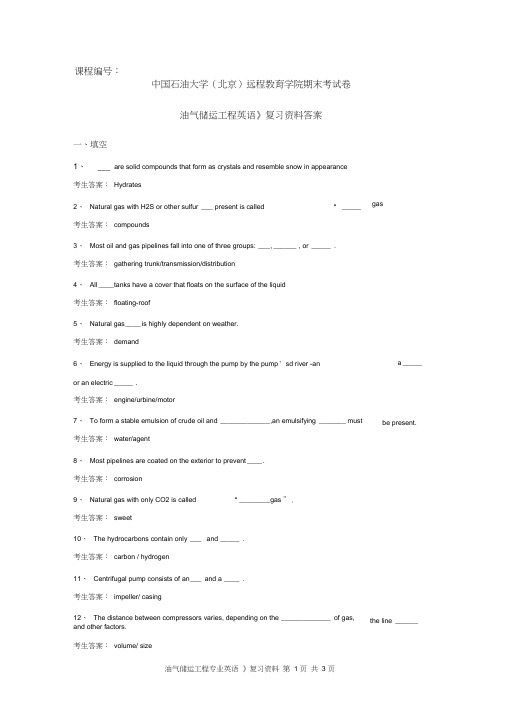
中国石油大学(北京)远程教育学院期末考试卷油气储运工程英语》复习资料答案一、填空1、 ___ are solid compounds that form as crystals and resemble snow in appearance考生答案: Hydrates2、 Natural gas with H2S or other sulfur ___ present is called “ _____考生答案: compounds3、 Most oil and gas pipelines fall into one of three groups: ___ , ______ , or _____ .考生答案: gathering trunk/transmission/distribution4、 All ____ t anks have a cover that floats on the surface of the liquid考生答案: floating-roof5、 Natural gas ____ is highly dependent on weather.考生答案: demand6、 Energy is supplied to the liquid through the pump by the pump ' sd river -anor an electric _____ .考生答案: engine/urbine/motor7、 To form a stable emulsion of crude oil and _____________ ,an emulsifying _______ must考生答案: water/agent8、 Most pipelines are coated on the exterior to prevent ____ .考生答案: corrosion9、 Natural gas with only CO2 is called “ ________ g as ”.考生答案: sweet10、 The hydrocarbons contain only ___ and _____ .考生答案: carbon / hydrogen11、 Centrifugal pump consists of an ___ and a ____ .考生答案: impeller/ casing12、 The distance between compressors varies, depending on the _____________ of gas,and other factors.考生答案: volume/ size课程编号:gas a _____ be present. the line ______13、In designing a pipeline system, the ____________ of pump stations must be determined as wellas ____ of individual pumps within each station.考生答案:location/size14、The type of information gathered by smart pigs includes the pipeline _________________ , curvature, bends, temperature and _____ , as well as ____ or metal loss.考生答案:diameter pressure/corrosion15、____ is short for American Petroleum Institute.考生答案:API16、The two categories of floating-roof tanks are _______________ floating roof and ____________ f loating roof.考生答案:external/internal17、Gas is moved through a gas pipeline by ___ .考生答案:compressors18、____ i s always necessary for hydrate formation.考生答案:Water19、The pressure in the pipeline decreases due to ___ and ______ losses.考生答案:friction /elevation20、Most pipelines are tested with water ( ____________ testing) either in sections or over theentire _____ .考生答案:hydrostati/length21、The position of ____ and the extent of mixing can be monitored at points along theline by measuring the ____ of the fluid in the line.考生答案:batch /density22、All pipelines are tested for ____________ following ____ before the line is put into service.考生答案:leaks/ construction23、Well fluids are often a complex mixture of ___ ,gas,and some ______ .考生答案:liquid hydrocarbons <mpuritie24、The individual phases (gas, ________ , ______ , and solids) should be separated from each other as early as practical.考生答案:liquid hydrocarbon /liquid water25、Launcher (at the end of a station to launch _______________ t o downstream station) is requiredat the _____ of the section.考生答案:pig/ upstream26、An emulsion is a combination of __________ ,or liquids that do not mix together under normal conditions .27、Products pipeline often must operate at ______________ pressure than crude pipelines becausethe material being transported is _____ than crude.考生答案:higher lighter28、Shipping emulsified oil wastes costly ___ occupied by valueless water.考生答案:transportation capacities29、When no physical barrier is used between different products in products pipeline,the _____ of the two materials maintains the separation.考生答案:difference in density30、Reciprocating compressor unit includes ____ and _____ .考生答案:compressor driver compressor31、Two general types of line pipe are manufactured: ____ and _____ .考生答案:seamless welded32、In pumping any liquid, the goal is to add energy to the liquid to cause it to movethrough a pipeline by overcoming the _____ and changes in _____ .考生答案:friction elevation33、The ____ of the substance stored determines the shape and type of tank.考生答案:vapor pressure34、Standing storage losses result from evaporative losses through ___________________ ,______ , and/or deck seam.考生答案:rim seals deck fitting35、There is 8~12in gap between the __________ and _______ , so the floating roof does not bindas it moves up and down with the liquid level.36、Many crude storage tanks are equipped with ____ that capture light hydrocarbonsthat evaporate from the crude and would otherwise be lost to the atmosphere.考生答案:vapor recovery systems37、Many different corrosion ___ and ______ of corrosion can be at work on the sametank at the same time.考生答案:mechanisms38、Mass-flow meters directly measure the mass of the fluid passing through the meter,no intermediate temperature or pressure ______________ are required and __________ is about the same as PD or turbine meters.考生答案:measurements39、Most pipelines are constructed by ___ short lengths or _____ of pipe together考生答案:welding joints40、NGL is short for ___ .考生答案:atural Liquids41、ESD is short for ___ .考生答案:emergency shutdown42、LNG is short for ___ .考生答案:Liquefied atural43、EFR is short for ___ .考生答案: E xternal F loating R Roof44、LACT unit is short for ___ .考生答案:ease automatic custody transfer unit45、IFR is short for ____ .考生答案:I nternal F loating Roof46、PD meters are short for ____ .考生答案:positive-displacement meters47、PV Valves is short for ___ .考生答案:pressure vacuum vent valves翻译题48、Oil-in-water emulsion考生答案:水包油乳状液49、Emulsion考生答案:乳状液50、Well fluids are often a complex mixture of liquid hydrocarbons,gas,and some impurities .考生答案:井流通常是液态烃、气体和某些杂质的复杂混合物。
2022年中国石油大学(北京)油气储运工程专业考研必看成功上岸前辈复习经验分享

2022年中国石油大学(北京)油气储运工程专业考研备考成功经验必看分享一、考研下定决心在我进入研究生阶段以来,我感觉考研升学是我大学毕业之后,做的最正确的一件事之一。
在研一阶段,各种的课程紧紧包围着我,但是,虽然很忙碌,导师依然会让你去实验室帮着师兄师姐做实验,有人可能觉得这是压榨,但我却不这么认为,这只能说明老师很负责,而且,老师每个月还会多给你几百块钱。
既能学知识又有钱话,何乐而不为呢,如果你的导师或者师兄师姐要发什么有水平的文章,或许还会加上你的名字奥。
总之,一句话,研究生生涯,选对老师是不会荒废的,欢迎看到此篇文章的小伙伴报考中国石油大学(北京)。
二、关于中国石油大学(北京)油气储运工程专业中国石油大学(北京)位于北京市昌平区,与中国政法大学距离不到五百米,是双一流建设高校、211工程大学以及985优势创新平台。
中国石油大学(北京)与中国石油大学(华东)是同根同源的学校,虽然现在是两地办学,两所知名高校。
但是可想而知,一所211工程大学既然能够重组成两所双一流建设高校,足可以看出学校的实力不俗。
中国石油大学(北京)由油气储运工程专业是国家级一流本科专业,随着现在人工智能的兴起,油气储运专业也迈向了新工科的定位。
向网络化、智能化、国际化、安全可靠性方向发展。
而且学校是以石油为特色的学校,所以当你选择中石大油气储运工程专业时,可想而知以后的方向是多么可期的。
三、关于初试复习中国石油大学(北京)的油气储运工程专业考查的科目是英语一、数学二、思想政治理论和专业课油气储运工程综合。
英语一就是要难一些,不过这个也是没有办法选择的,因为,都是跟专业捆绑在一起的,除非你去考专硕,考英语二,听说英语二要简单一些。
英语一的真题要多刷几遍,尤其是里面的长难句更是重点,在阅读里会出现一些合成词,这个就需要你掌握一些词根词缀的方法,再接合阅读文章的意思,这样就能做的很顺手。
坚持每天50个单词,从六月份开始,坚持到考前一天。
油气储运专业英语
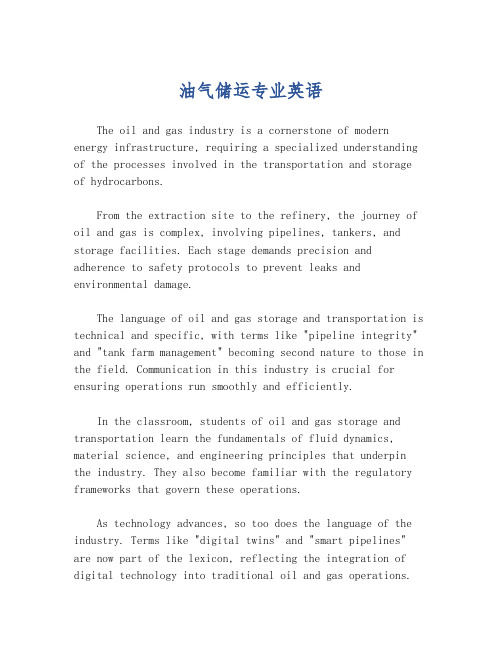
油气储运专业英语The oil and gas industry is a cornerstone of modern energy infrastructure, requiring a specialized understanding of the processes involved in the transportation and storage of hydrocarbons.From the extraction site to the refinery, the journey of oil and gas is complex, involving pipelines, tankers, and storage facilities. Each stage demands precision and adherence to safety protocols to prevent leaks and environmental damage.The language of oil and gas storage and transportation is technical and specific, with terms like "pipeline integrity" and "tank farm management" becoming second nature to those in the field. Communication in this industry is crucial for ensuring operations run smoothly and efficiently.In the classroom, students of oil and gas storage and transportation learn the fundamentals of fluid dynamics, material science, and engineering principles that underpin the industry. They also become familiar with the regulatory frameworks that govern these operations.As technology advances, so too does the language of the industry. Terms like "digital twins" and "smart pipelines" are now part of the lexicon, reflecting the integration of digital technology into traditional oil and gas operations.The global nature of the oil and gas industry means that professionals must be fluent in English, the lingua franca of international business. This proficiency enablescollaboration across borders and the sharing of best practices worldwide.Continuing education is essential for those in the field, as new methods and technologies are constantly emerging. This includes staying abreast of the latest in English-language literature on topics like offshore drilling and LNG shipping.In summary, mastering the English language in the context of oil and gas storage and transportation is not just about understanding technical jargon; it's about being able to communicate effectively in an ever-evolving global industry.。
毕业设计(论文)英文扉页参考模板
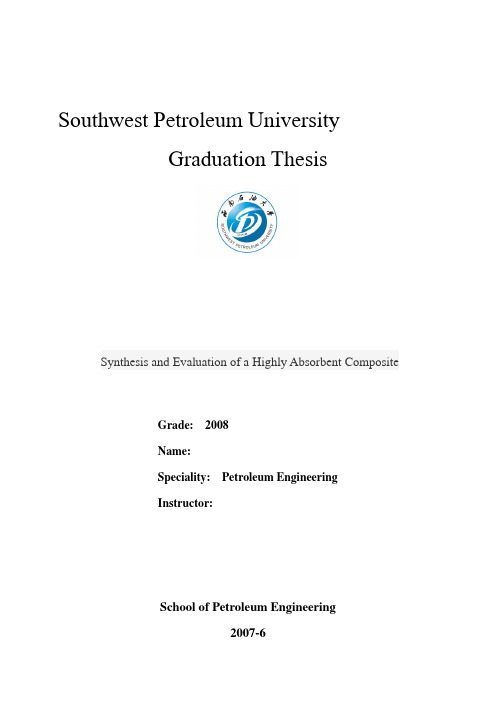
Southwest Petroleum UniversityGraduation ThesisSynthesis and Evaluation of a Highly Absorbent CompositeGrade: 2008Name:Speciality: Petroleum EngineeringInstructor:School of Petroleum Engineering2007-6附:我校设置的专业中英文对照(摘自《普通高等学校本科专业目录和专业介绍》)1、石油工程学院080102石油工程Petroleum Engineering081203油气储运工程Oil/ Gas Storage and Transportation Engineering2、资源与环境学院080105资源勘查工程Natural Resources Prospecting Engineering080104勘查技术与工程Prospecting Techniques and Engineering070702资源环境与城乡规划管理Urban and Rural Planning & Resource Management070703地理信息系统Geographical Information System3、机电工程学院080305Y机械工程及自动化Mechanical Engineering and Automation080304过程装备与控制工程Process Equipment and Control080303工业设计Industrial Design4、化学化工学院081101化学工程与工艺Chemical Engineering and Technology070302应用化学Applied Chemistry081001环境工程Environmental Engineering081801生物工程Bioengineering070301化学Chemistry5、材料科学与工程学院080204高分子材料与工程Macromolecular Materials and Engineering080205Y材料科学与工程Material Science and Engineering6、计算机科学学院080605计算机科学与技术Computer science and Technology080611W软件工程Software Engineering080613W网络工程Network Engineering7、电信工程学院080401测控技术与仪器Measuring & Control Technology and Instrumentations 080602自动化Automation080603电子信息工程Electronic and Information Engineering080601电气工程及其自动化Electrical Engineering and Automation080604通信工程Telecommunications Engineering8、建筑工程学院080703土木工程Civil Engineering080704建筑环境与设备工程Building Environment and Equipment Engineering 080901测绘工程Surveying & Mapping Engineering110104工程管理Project Management9、理学院070102信息与计算科学Information and Computing Science070101数学与应用数学Mathematics and Applied Mathematics071201电子信息科学与技术Electronic and Information Science and Technology 070202应用物理学Applied Physics10、经济管理学院110201工商管理Business Administration110202市场营销Marketing110102信息管理与信息系统Information Management & Information System 020101经济学Economics110209W电子商务Electronic Business020102国际经济与贸易International Economics & Trade11、人文社会科学学院030302社会工作Social Work110309W公共管理Public Administration12、法学院030101法学Law13、外语系050201英语English14、体育系。
专业代码

专业代码、名称及研究方向人数考试科目备注001 地球科学学院070900 地质学01沉积学及古地理学02岩石学和储层地质学03层序地层学和测井地质学04有机地球化学05区域构造及盆地分析06油区构造解析07化石能源形成与富集机制08古生物学与地层学70①101政治②201英语一或202俄语③302数学二④801地质学综合I.同等学力加试科目从造岩矿物学、岩浆岩与变质岩石学、古生物学与地史学中任选2门。
II.留一定比例(不超过10%)招生计划接收”985”学校(本部)调剂生源,奖学金按学院政策执行。
077601 环境科学01城市大气环境02环境地质与环境地球化学03能源与环境04环境分析技术与评价8①101政治②201英语一③302数学二④803环境学概论(含环境化学)I.同等学力加试科目:环境化学,有机化学。
II.留一定比例(不超过10%)招生计划接收”985”学校(本部)调剂生源,奖学金按学院政策执行。
III.按理学招生。
081800 地质资源与地质工程01含油气盆地分析与资源评价02油气藏形成机理与分布规律03油气田开发地质04地球信息技术96①101政治②201英语一或202俄语③302数学二④802石油地质综合I.同等学力加试科目:油气田勘探、石油地质学。
II.留一定比例(不超过10%)招生计划接收”985”学校(本部)调剂生源,奖学金按学院政策执行。
002 石油工程学院080100力学01 岩石力学5①101政治②201英语一或202俄语③301数学一④828力学综合I.力学综合包括弹性力学、流体力学、渗流力学。
II.同等学力加试科目:材料力02 多相流体力学03 渗流力学04 管柱力学学,理论力学。
同等学力的考生请与所报导师联系。
III.欢迎力学、机械、化学、采矿及地质工程等专业的本科生报考。
IV.本专业的调剂考生仅限于985高校。
082001 油气井工程01油气井力学与控制工程02油气井岩石力学与工程03油气井流体力学与工程04油气井化学与工程60① 101政治②201英语一或202俄语③302数学二④823油气井工程综合(I)或824 油气井工程综合(I I) ( 或862 物理化学(工)(04方向))I.油气井工程综合(I) 包括工程力学和流体力学,油气井工程综合(I I) 包括钻井工程、完井工程和钻井液工艺原理。
2016-2017中国石油大学油气储运工程考试科目、考研真题、考研参考书目考研经验--新祥旭考研辅导
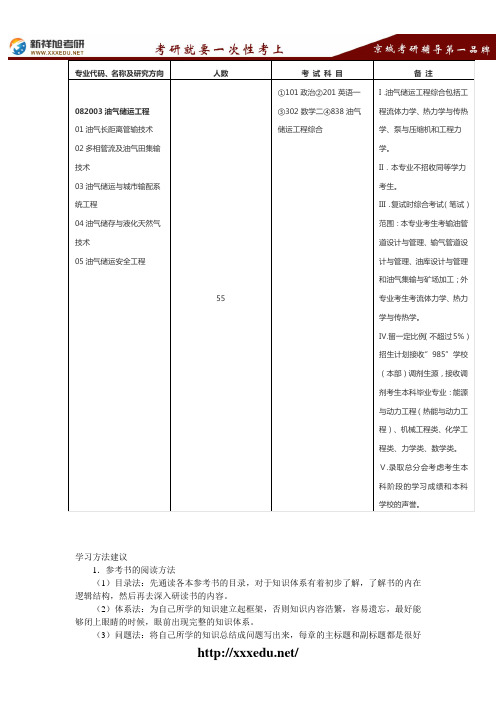
专业代码、名称及研究方向人数考试科目备注082003油气储运工程01油气长距离管输技术02多相管流及油气田集输技术03油气储运与城市输配系统工程04油气储存与液化天然气技术05油气储运安全工程55 ①101政治②201英语一③302数学二④838油气储运工程综合I.油气储运工程综合包括工程流体力学、热力学与传热学、泵与压缩机和工程力学。
II.本专业不招收同等学力考生。
III.复试时综合考试(笔试)范围:本专业考生考输油管道设计与管理、输气管道设计与管理、油库设计与管理和油气集输与矿场加工;外专业考生考流体力学、热力学与传热学。
Ⅳ.留一定比例(不超过5%)招生计划接收”985”学校(本部)调剂生源,接收调剂考生本科毕业专业:能源与动力工程(热能与动力工程)、机械工程类、化学工程类、力学类、数学类。
Ⅴ.录取总分会考虑考生本科阶段的学习成绩和本科学校的声誉。
学习方法建议1.参考书的阅读方法(1)目录法:先通读各本参考书的目录,对于知识体系有着初步了解,了解书的内在逻辑结构,然后再去深入研读书的内容。
(2)体系法:为自己所学的知识建立起框架,否则知识内容浩繁,容易遗忘,最好能够闭上眼睛的时候,眼前出现完整的知识体系。
(3)问题法:将自己所学的知识总结成问题写出来,每章的主标题和副标题都是很好的出题素材。
尽可能把所有的知识要点都能够整理成问题。
2. 学习笔记的整理方法(1)通过目录法、体系法的学习形成框架后,在仔细看书的同时应开始做笔记,笔记在刚开始的时候可能会影响看书的速度,但是随着时间的发展,会发现笔记对于整理思路和理解课本的内容都很有好处。
(2)做笔记的方法不是简单地把书上的内容抄到笔记本上,而是把书上的内容整理成为一个个小问题,按照题型来进行归纳总结。
3.真题的使用方法分析试题主要应当了解以下几个方面:命题的风格(如难易程度,是注重基础知识、应用能力还是发挥能力)、题型、题量、考试范围、分值分布、考试重点、考查的侧重点等。
油气储运专业英语
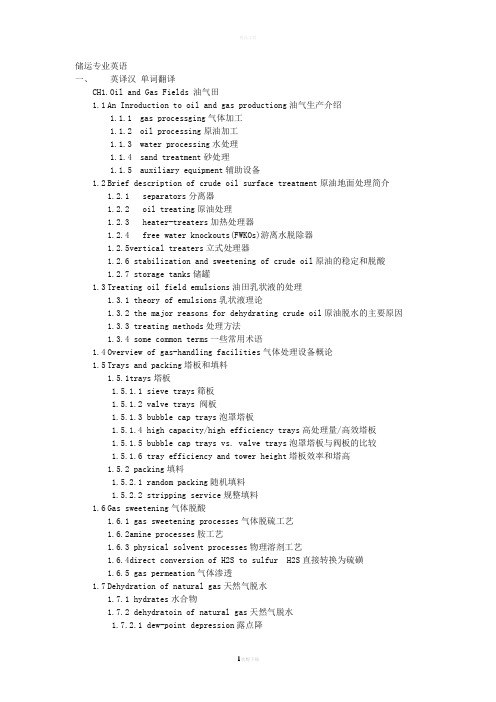
储运专业英语一、英译汉单词翻译CH1.Oil and Gas Fields 油气田1.1An Inroduction to oil and gas productiong油气生产介绍1.1.1gas processging气体加工1.1.2oil processing原油加工1.1.3water processing水处理1.1.4sand treatment砂处理1.1.5auxiliary equipment辅助设备1.2Brief description of crude oil surface treatment原油地面处理简介1.2.1 separators分离器1.2.2 oil treating原油处理1.2.3 heater-treaters加热处理器1.2.4 free water knockouts(FWKOs)游离水脱除器1.2.5vertical treaters立式处理器1.2.6 stabilization and sweetening of crude oil原油的稳定和脱酸1.2.7 storage tanks储罐1.3Treating oil field emulsions油田乳状液的处理1.3.1 theory of emulsions乳状液理论1.3.2 the major reasons for dehydrating crude oil原油脱水的主要原因1.3.3 treating methods处理方法1.3.4 some common terms一些常用术语1.4Overview of gas-handling facilities气体处理设备概论1.5Trays and packing塔板和填料1.5.1trays塔板1.5.1.1 sieve trays筛板1.5.1.2 valve trays 阀板1.5.1.3 bubble cap trays泡罩塔板1.5.1.4 high capacity/high efficiency trays高处理量/高效塔板1.5.1.5 bubble cap trays vs. valve trays泡罩塔板与阀板的比较1.5.1.6 tray efficiency and tower height塔板效率和塔高1.5.2 packing填料1.5.2.1 random packing随机填料1.5.2.2 stripping service规整填料1.6Gas sweetening气体脱酸1.6.1 gas sweetening processes气体脱硫工艺1.6.2amine processes胺工艺1.6.3 physical solvent processes物理溶剂工艺1.6.4direct conversion of H2S to sulfur H2S直接转换为硫磺1.6.5 gas permeation气体渗透1.7Dehydration of natural gas天然气脱水1.7.1 hydrates水合物1.7.2 dehydratoin of natural gas天然气脱水1.7.2.1 dew-point depression露点降1.7.2.2 liquid-desiccant dehydrators液体干燥剂脱水器1.8Hydrocarbon recovery and condensate stabilization烃回收和凝液稳定1.8.1hydrocarbon recovery processes烃回收工艺1.8.2absorber and stripper units吸收塔和气提装置1.8.3 condensate stabilization凝液稳定CH2 Pipelines管道2.1 types of pipelines管道类型2.1.1 oil pipelines输油管道2.1.1.1 flowlines出油管2.1.1.2 gathering lines集油管道2.1.1.3crude trunk lines原油干线管道2.1.2 gas pipelines输气管道2.1.2.1gas gathering集气管道2.1.2.2gas transmission输气干线2.1.3 products pipelines成品油管道2.2 other pipelines其他管道2.2.1two-phase pipelines两相流管道2.2.2LNG pipelines液化天然气管道2.2.3 CO2 pipelines CO2管道2.2.4 coal slurry pipelines煤浆管道2.3 rheology流变学2.3.1 what is rheology? 什么是流变学?2.3.2 viscosity黏度2.3.3 non-newtonian liquids非牛顿流体2.3.4 high pour and high viscosity高倾点和高粘度2.4 line pipes管道用管2.4.1 specifications规范2.4.2 steel pipe钢管2.4.3 other types of pipe其他类型的管子2.5 pumps and pump stations泵和泵站2.5.1 investment distributions投资分配2.5.2 pump stations泵站2.5.2.1 the number of pump stations泵站数2.5.2.2 station equipment泵站设备2.5.3 pumps泵2.5.3.1 centrifugal pumps容积泵2.5.4 types of station operation泵站操作类型2.5.4.1 put and take operation罐到罐操作2.5.4.2 float tank operation旁接罐操作2.5.4.3 tight line operation密闭操作2.6 compressors压缩机2.6.1 reciprocating compressors往复式压缩机2.6.2 centrifugal compressors离心压缩机2.6.3 compression ratio压缩比2.6.4 capacity and horsepower流量和功率2.6.5 other considerations其他考虑因素2.7 gas turbines燃气透平2.7.1 types of gas turbines燃气透平类型2.7.2 operation操作2.8 pipeline pigging管道清管2.8.1 pigging 清管2.8.2 example of pigging operatings清管操作的例子2.8.3 launching and receiving发送和接收2.9 pipe coating管子覆盖层2.9.1 exterior corrosion coating外防腐覆盖层2.9.2 concrete coating混凝土加重层2.10 inspection and rehabilitation检查和修复2.10.1 inspecion检查2.10.2 in-line tools管内检查器2.10.3 rehabilitation修复2.10.3.1 external corrosion外腐蚀2.10.3.2 trans alaska pipeline repair横贯阿拉斯加管道的修理CH3 storage facilities储存设施3.1 storage储存3.1.1 crude storage原油储存3.1.2 natural gas liquids天然气凝析油3.1.3 natural gas天然气储存3.1.4LNG 液化天然气3.2 tand classification罐的分类3.2.1 tank classification储罐分类3.2.1.1 atmospheric tanks常压罐3.2.1.2 low-pressure tanks低压罐3.2.1.3 pressure vessels (high-pressure tanks)压力容器(高压罐)3.2.2 major tank components储罐主要部件3.2.2.1 fixed-foof tanks固定顶储罐3.2.2.2 floating-roof tanks浮顶罐3.2.2.3 tank bottoms罐底3.3 floating roofs浮顶3.3.1 external floating roofs外浮顶3.3.1.1 roof types顶的类型3.3.1.2 support legs支柱3.3.1.3 vents通风3.3.1.4 drainage排水3.3.1.5 wind girders抗风圈3.3.2 internal floating roofs内浮顶3.3.2.1 steel roofs钢顶3.3.2.2 aluminum roofs铝顶3.4 rim seals边缘密封3.4.1 external floating-roof seals外浮顶密封3.4.1.1 mechanical shoe seals机械滑板密封3.4.1.2 resilint toroid seals弹性环密封3.4.1.3 flexible wiper seals柔性刷密封3.4.1.4 weather shield风雨罩3.4.2 internal floating-roof seals内浮顶密封3.5 tank emissions and venting储罐发散物和通风3.5.1 mechanisms of evaporation losses蒸发损耗机理3.5.1.1 fixed-roof tanks固定顶储罐3.5.2 tank type and emissions储罐类型和发散3.5.2.1 fixed-roof tanks固定顶罐3.5.2.2 external floating-roof tanks外浮顶罐3.5.2.3 internal floating-roof tanks内浮顶罐3.5.3PV valves压力真空阀3.5.3.1 general概要3.5.3.2 how the PV valve works PV阀的工作3.5.4 emergency venting 应急泄压3.6 tank foundations储罐基础3.6.1 introduction to tank foundations储罐基础介绍3.6.1.1 preliminary studies初步研究3.6.1.2 soil investigations土壤研究3.6.2 imprtant elements to consider in foundation design基础设计中考虑的重要因素3.6.2.1 foundation elevation基础标高3.6.2.2 drainage排水3.6.2.3 oil sand under tank bottom罐底下的油砂3.6.3 tank foundation types储罐基础类型3.6.3.1 concrete ringwall foundations混凝土圈座基础3.6.3.2 crushed-srone ringwall foundations碎石圈座基础3.6.3.3compacted soil foundations夯土基础3.6.3.4 slab foundations平板基础3.6.3.5 pile-supported foundations桩柱支撑基础3.7 fire prevention and foam system防火和泡沫系统3.7.1 foam fire fighting systems泡沫灭火系统3.7.1.1 fluidity流动性3.7.1.2 expansion膨胀性3.7.1.3drainage rate吸水率3.7.2 foam making devices泡沫发生装置3.8 oil storage in rock caverns在岩洞内储存石油3.8.1 storage at 1 atmosphere在大气压下储存3.8.2 cavern design and constrution岩洞设计及建造3.8.3 general operation and maintenance操作和维护3.8.3.1 pumps泵3.8.3.2 heating加热3.8.3.3 sludge 沉积物3.8.3.4 level control and volume measurement液位控制和体积测量3.8.4 advantages of rock cavern storage岩洞储存的优点CH4 construcion建设4.1 land pipeline construction陆上管道建设4.1.1 construction classification建设分类4.1.2 land pipeline construction陆上管道建设4.2 pipeline installation and road/river crossing管道安装和管道/河流穿越4.2.1 installaton安装4.2.2 road/river crossings道路/河流的穿越4.2.3 testing试压4.2.4 drying and cleaning干燥和清管4.2.5 station construction站的建设4.3 offshore pipeline construction海洋管道建设4.3.1 conventional lay barge常规铺管船4.3.2 reel barge卷筒船4.3.3 vertical pipelaying垂直铺管4.4 pull methods and tie-in牵引法和碰固定口连接4.4.1 pull methods牵引法4.4.2 tie-in碰固定口连接4.5 welding techniques and equipment焊接技术和设备4.5.1 welding processes焊接工艺4.5.2 welding procedures and equipment焊接程序及设备4.5.2.1 weld passes焊道4.5.2.2 manual welding手工焊接4.5.2.3 automatic welding自动焊4.5.2.4 preparation for welding焊接准备4.5.2.5 inspection and testing检查与试验4.5.2.6 weld defects焊接缺陷4.5.3 other joining methods其他连接方法CH5 corrosion腐蚀5.1 cause of underground corrosion地下腐蚀的原因5.1.1 electrolytic corrosion电解腐蚀5.1.2 galvanic corrosion电池腐蚀5.1.2.1 dissimilar metals不同金属5.1.2.2 dissimilar environments不同环境5.2 cathodic protection fundamentals阴极保护的基本原理5.2.1 corrosion and corrosion control腐蚀和服饰控制5.2.1.1 electrically insulating anode area from cathodic area阳极区和阴极区的电绝缘5.2.1.2 electrically insulating anode or cathode from the elecrolyte阳极或阴极与电解质的电绝缘5.2.1.3 treatment of electrolyte电解质处理5.2.1.4 use of nonmetallic materials非金属材料的应用5.2.2 cathodic protection阴极保护5.2.2.1 galvanic cathodic protection systems原电池阴极保护系统5.2.2.2 impressed current systems外加电流系统5.2.3 design and criteria for cathodic protection阴极保护的设计和准则5.3 pipeline corrosion管道腐蚀5.3.1 estimating the corrosion risk腐蚀风险评估5.3.1.1 intrinsic corrosiveness of the soil土壤固有的腐蚀性5.3.1.2 electrolytic effects电解作用5.3.2 corrosion protection腐蚀防护5.3.2.1 insulating coatings绝缘涂层5.3.2.2 cathodic protection阴极保护5.3.2.3 protection against electrolysis电解的保护5.4 tank corrosion储罐腐蚀5.4.1 descriptive nature of tank corrosion储罐腐蚀性质描述5.4.1.1 atmospheric corrosion大气腐蚀5.4.1.2 product side corrosion油品接触面腐蚀5.4.1.3 bottom corrosion罐底腐蚀5.4.1.4 vapor space corrosion蒸气空间腐蚀5.4.1.5 interface corrosion界面腐蚀5.4.1.6 bottom underside corrosion罐底下侧腐蚀5.4.2 corrosion control and prevention腐蚀控制及防护5.4.3 specific storage tank corrosion service problems专用储罐的腐蚀问题(石油产品)5.4.3.1 crude oil tanks原油储罐5.4.3.2 refined hydrocarbon storage tanks成品油储罐5.4.4 corrosion prevention with linings用涂层防腐5.4.4.1 basic types of lining涂层的基本类型5.4.4.2 surface preparation表面预处理5.4.4.3 precleaning预清洗5.4.4.4 abrasive blasting喷磨处理5.4.4.5 other surface preparation methods其他表面预处理方法5.4.5 corrosion prevention with cathodic protection用阴极保护防止腐蚀5.4.5.1 cathodic protection阴极保护5.4.5.2 polarization极化5.4.5.3 electrical potential measurement电位测量5.4.5.4 current requirements电流需求5.4.5.5 internal versus external cathodic protection内部与外部阴极保护CH6 metering installations计量装置6.1 metering gases气体计量6.1.1differential pressure meters差压流量计6.1.2 positive-displacement meters(PD)容积式流量计(PD)6.1.3 turbine-type meters涡轮流量计6.1.4 mass-flow meters质量流量计6.2metering of liquids液体计量6.2.1 types of meters in use在用流量计类型6.2.2 positive-displacement meters容积式流量计6.2.3 turbine meters涡轮流量计6.2.4 meter calibration流量计标定6.3 BTU measurement热值测量欢迎您的下载,资料仅供参考!致力为企业和个人提供合同协议,策划案计划书,学习资料等等打造全网一站式需求。
工业专业专用术语英文词汇

工学专业名称英语力学Mechanics一般力学与力学基础General and Fundamental Mechanics固体力学Solid Mechanics流体力学Fluid Mechanics工程力学Engineering Mechanics机械工程Mechanical Engineering机械制造及其自动化Mechanical Manufacture and Automation机械电子工程Mechatronic Engineering机械设计与理论Mechanical Design and Theory车辆工程Vehicle Engineering光学工程Optical Engineering仪器科学与技术Instrument Science and Technology精密仪器及机械Precision Instrument and Machinery测试计量技术及仪器Measuring and Testing Technologies and Instruments材料科学与工程Materials Science and Engineering材料物理与化学Materials Physics and Chemistry材料学Materialogy材料加工工程Materials Processing Engineering冶金工程Metallurgical Engineering冶金物理化学Physical Chemistry of Metallurgy钢铁冶金Ferrous Metallurgy有色金属冶金Non-ferrous Metallurgy动力工程及工程热物理Power Engineering and Engineering Thermophysics工程热物理Engineering Thermophysics热能工程Thermal Power Engineering动力机械及工程Power Machinery and Engineering流体机械及工程Fluid Machinery and Engineering制冷及低温工程Refrigeration and Cryogenic Engineering化工过程机械Chemical Process Equipment电气工程Electrical Engineering电机与电器Electric Machines and Electric Apparatus电力系统及其自动化Power System and its Automation高电压与绝缘技术High V oltage and Insulation Technology电力电子与电力传动Power Electronics and Power Drives电工理论与新技术Theory and New Technology of Electrical Engineering电子科学与技术Electronics Science and Technology物理电子学Physical Electronics电路与系统Circuits and Systems微电子学与固体电子学Microelectronics and Solid State Electronics电磁场与微波技术Electromagnetic Field and Microwave Technology信息与通信工程Information and Communication Engineering通信与信息系统Communication and Information Systems信号与信息处理Signal and Information Processing945控制科学与工程Control Science and Engineering控制理论与控制工程Control Theory and Control Engineering检测技术与自动化装置Detection Technology and Automatic Equipment系统工程Systems Engineering模式识别与智能系统Pattern Recognition and Intelligent Systems导航、制导与控制Navigation, Guidance and Control计算机科学与技术Computer Science and Technology计算机软件与理论Computer Software and Theory计算机系统结构Computer Systems Organization计算机应用技术Computer Applied Technology建筑学Architecture建筑历史与理论Architectural History and Theory建筑设计及其理论Architectural Design and Theory城市规划与设计(含风景园林规划与设计) Urban Planning and Design (includingLandscape Planning and Design)建筑技术科学Building Technology Science土木工程Civil Engineering岩土工程Geotechnical Engineering结构工程Structural Engineering市政工程Municipal Engineering供热、供燃气、通风及空调工程Heating, Gas Supply, Ventilating and AirConditioning Engineering防灾减灾工程及防护工程Disaster Prevention and Reduction Engineering andProtective Engineering桥梁与隧道工程Bridge and Tunnel Engineering水利工程Hydraulic Engineering水文学及水资源Hydrology and Water Resources水力学及河流动力学Hydraulics and River Dynamics水工结构工程Hydraulic Structure Engineering水利水电工程Hydraulic and Hydro-Power Engineering港口、海岸及近海工程Harbor, Coastal and Offshore Engineering测绘科学与技术Surveying and Mapping大地测量学与测量工程Geodesy and Survey Engineering摄影测量与遥感Photogrammetry and Remote Sensing地图制图学与地理信息工程Cartography and Geographic Information Engineering化学工程与技术Chemical Engineering and Technology化学工程Chemical Engineering化学工艺Chemical Technology生物化工Biochemical Engineering应用化学Applied Chemistry工业催化Industrial Catalysis地质资源与地质工程Geological Resources and Geological Engineering矿产普查与勘探Mineral Resource Prospecting and Exploration地球探测与信息技术Geodetection and Information Technology946矿业工程Mineral Engineering采矿工程Mining Engineering矿物加工工程Mineral Processing Engineering安全技术及工程Safety Technology and Engineering石油与天然气工程Oil and Natural Gas Engineering油气井工程Oil-Gas Well Engineering油气田开发工程Oil-Gas Field Development Engineering油气储运工程Oil-Gas Storage and Transportation Engineering纺织科学与工程Textile Science and Engineering纺织工程Textile Engineering纺织材料与纺织品设计Textile Material and Textiles Design纺织化学与染整工程Textile Chemistry and Dyeing and Finishing Engineering服装设计与工程Clothing Design and Engineering轻工技术与工程The Light Industry Technology and Engineering制浆造纸工程Pulp and Paper Engineering制糖工程Sugar Engineering发酵工程Fermentation Engineering皮革化学与工程Leather Chemistry and Engineering交通运输工程Communication and Transportation Engineering道路与铁道工程Highway and Railway Engineering交通信息工程及控制Traffic Information Engineering Control交通运输规划与管理Transportation Planning and Management载运工具运用工程Vehicle Operation Engineering船舶与海洋工程Naval Architecture and Ocean Engineering船舶与海洋结构物设计制造Design and Construction of Naval Architecture andOcean Structure轮机工程Marine Engine Engineering水声工程Underwater Acoustics Engineering航空宇航科学与技术Aeronautical and Astronautical Science and Technology飞行器设计Flight Vehicle Design航空宇航推进理论与工程Aerospace Propulsion Theory and Engineering航空宇航器制造工程Manufacturing Engineering of Aerospace Vehicle人机与环境工程Man-Machine and Environmental Engineering兵器科学与技术Armament Science and Technology武器系统与运用工程Weapon Systems and Utilization Engineering兵器发射理论与技术Armament Launch Theory and Technology火炮、自动武器与弹药工程Artillery, Automatic Gun and Ammunition军事化学与烟火技术Military Chemistry and Pyrotechnics核科学与技术Nuclear Science and Technology核能科学与工程Nuclear Energy Science and Engineering核燃料循环与材料Nuclear Fuel Cycle and Materials核技术及应用Nuclear Technology and Applications辐射防护及环境保护Radiation and Environmental Protection947农业机械化工程Agricultural Mechanization Engineering农业水土工程Agricultural Water-Soil Engineering农业生物环境与能源工程Agricultural Biological Environmental and Energy农业电气化与自动化Agricultural Electrification and Automation林业工程Forestry Engineering森林工程Forest Engineering木材科学与技术Wood Science and Technology林产化学加工工程Chemical Processing Engineering of Forest Products环境科学与工程Environmental Science and Engineering环境科学Environmental Science环境工程Environmental Engineering生物医学工程Biomedical Engineering食品科学与工程Food Science and Engineering食品科学Food Science粮食、油脂及植物蛋白工程Cereals, Oils and Vegetable Protein Engineering农产品加工及贮藏工程Processing and Storage of Agriculture Products水产品加工及贮藏工程Processing and Storage of Aquatic Products948。
海洋油气工程专业英语1
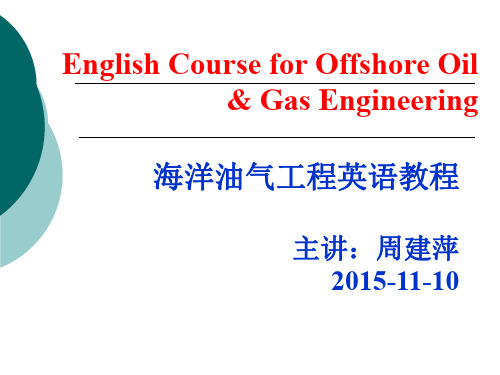
New words
TLP( Tension Leg Platform) 张力腿平台 viscous effect 黏滞效应 wave diffraction 波浪绕射 wave frequency motion 波频运动 wave-induced motion 波浪诱导运动 wildcatter [ˈwaildkætə( r) ] n. 石油勘探者 yaw 艏摇
English Course for Offshore Oil & Gas Engineering 海洋油气工程英语教程
主讲:周建萍 2015-11-10
课程简介:
侧重培养学生阅读海洋油气工程专业相关英文文献
课程中讲授的英文资料涵盖了专业学习的各个环节。
及科技论文摘要写作能力。 包括:海洋油气工程环境、油藏工程基础、海洋钻井工 程、采油工程、产出液储运和处理、腐蚀防护、深水油 气技术。
1.1.1 The technical evolution of the offshore exploration
Scores of other venturers copied the pier and derrick technique along the California coast over the next ten years. At one, the Elwood field, the piers extended 1800 feet from the shore, and still reached a water depth of only 30 feet (9.1m). Not until 1932 did the Indian Oil Company courageously build a stand-alone platform in the shallow Pacific Ocean waters off Rincon California.
专业英语课程论文-油气储运工程Technical English for Oil and Gas
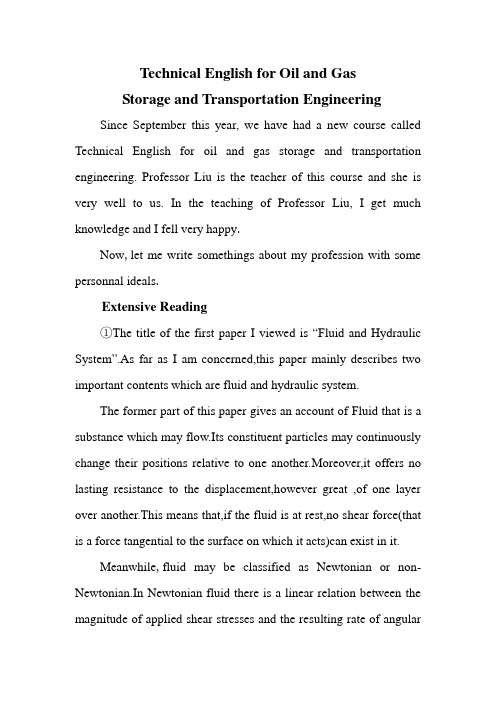
T echnical English for Oil and GasStorage and T ransportation Engineering Since September this year, we have had a new course called Technical English for oil and gas storage and transportation engineering. Professor Liu is the teacher of this course and she is very well to us. In the teaching of Professor Liu, I get much knowledge and I fell very happy.Now,let me write somethings about my profession with some personnal ideals.Extensive Reading①The title of the first paper I viewed is “Fluid and Hydraulic System”.As far as I am concerned,this paper mainly describes two important contents which are fluid and hydraulic system.The former part of this paper gives an account of Fluid that is a substance which may flow.Its constituent particles may continuously change their positions relative to one another.Moreover,it offers no lasting resistance to the displacement,however great ,of one layer over another.This means that,if the fluid is at rest,no shear force(that is a force tangential to the surface on which it acts)can exist in it.Meanwhile,fluid may be classified as Newtonian or non- Newtonian.In Newtonian fluid there is a linear relation between the magnitude of applied shear stresses and the resulting rate of angulardeformation.In non- Newtonian fluid there is a nonlinear relation between the magnitude of applied shear stresses and the resulting rate of angular deformation.The after part of this paper is concerned with the hydraulic system. I think the ligament between the two sides is “Pascal’s law”. Because all hydraulic systems depend on Pascal’s law,named after Braise Pascal, who discovered the law. This law states that pressurized fluid within a closed container-such as cylinder or pipe-exerts equal force on all of the surfaces of the container. Moreover, in actual hydraulic systems, Pascal’s law defines the basis of the results which are obtained from the system.Thus,pump moves the liquid in the system. The intake of the pump is connected to a liquid source,usually called the tank or reservoir. Atmospheric pressure,pressing on the liquid in the reservior,forces the liquid into the pump.when the pump operates,it forces liquid from the tank into the discharge pipe at a suitable pressure.②The title of the second paper I viewed is “A Discussion on Modern Design Optimization”. In this paper,the author focuses on the theory underlying some of the mathematical methods employed by design optimization procedures.To begin with, this paper treats of the optimization techniques taking one with another. The integration of optimization techniqueshas the power to reduce design costs by shifting the burden from the engineer to the computer. Furthermore,the mathematical rigor of a properly implemented potimization tool can add confidence to the design process.Modern optimization methods perform shape optimizations on components generated within a choice of CAD packages. Ideally, there is seamless data exchange via direct memory transfer between the CAD and FEA applications without the need for file translation. Furthermore, if associativity between the CAD and FEA software exist, any changes made in the CAD geometry are immediately reflected in the FEA model.The second, this paper describe how the optimization problem arises. Consider a three-step process:(1)Generation of geometry of part or assembly in CAD;(2)Creation of FEA mode of part or assembly;(3)Evaluation of results of FEA models.Meanwhile,most optimization problems are made up of three basic components.(1) An objective function which we want to minimize (or maximize). For instance, in designing an automobile panel, we might want to minimize the stress in a particular region.(2) A set of design variables that affect the value of theobjective function. In the automobile panel design problem, the variables used define the geometry and material of the panel.(3) A set of constraints that allow the design variables to have values but exclude others. In the automobile panel design problem, we would probably want limit its weight.The last but not the least, there is no beauideal in the world. Modern design optimization has many benefits and drawbacks. The elimination or reduction of repetitive manual tasks has been the impetus behind many software applications. Automatic design optimization is one of the latest applications used to reduce man-hours at the expense of possibly increasing the computational effort. It is even possible that an automatic design optimization scheme may actually require less computational effort than a manual approach. This is because the mathematical rigor on which these schemes are based may be more efficient than a human-based solution. Of course, these schemes do not replace human intuition, which can occasionally significantly shorten the design cycle. That is, no variable combination of the design parameters is left unconsidered. Thus,designs obtained using design optimization software should be accurate to within the resolution of the overall method.Intensive ReadingOriginal textIndustrial RobotA robot is an automatically controlled, reprogrammable, multipurpose, manipulating machine with several reprogrammable axes, which may be either fixed in place or mobile for use in industrial automation applications.The key words are reprogrammable and multipurpose because most single-purpose machines do not meet these two requirements. The term “multipurpose”means that the robot can perform many different functions, depending on the program and tooling cureently in use.Over the past two decades, the robot has been introduced into industry to perform many monotonous and often unsafe operations. Because robot can perform certain basic tasks more quickly and accurately than humans, they are being increasingly used in various manufacturing industries.The typical structure of industrial robot consists of 4 major components: the manipulator, the end effector, the power supply and the control system.The manipulator is a mechanical unit that provide motions similar to those of a human arm. It often has a shoulder joint, an elbow and a wrist. It can rotate or slide, stretch out and withdraw inevery possible direction with certain flexibility.The basic mechanical configurations of the robot manipulator are categorized as cartesian, cylindrical, spherical and ariculated. A robot with a cartesian geometry can move its gripper to any position within the cube or rectangle defined as its working volume. Cylindrical coordinate robots can move the gripper within a volume that is described by a cylinder. The cylindrical coordinate robot is positioned in the work area by two linear movements in the X and Y directions and one angular rotation about the axis. Spherical arm geometry robots position the wrist through two rotation and one linear actuation. Articulated industrial robots have an irregular work envelope. This type of robot has two main variants,vertically articulated and horizontally articulated.The end effector attaches itself to the end of robot wrist, also called end-of-arm tooling. It is the device intended for performing the designed operations as a human as a human hand can. End effectors are generally custom-made to meet special handling requirements. Mechanical grippers are the most commonly used and are equipped with two or more fingers. The selection of an appropriate end effector for a specific application depends on such factors as the payload, environment, reliability, and cost.The power supply is the actuator for moving the robot arm,controlling the joints and operating the end effector. The basic types of power sources include electrical, pneumatic, and hydraulic. Each source of energy and each type of motor has its own characteristics, advantages and limitations. An ac-powered or dc-powered motor may be used depending on the systerm design and applications. These motors convert electrical energy into mechanical energy to power the robot. Most new robot use electrical power supply. Pneumatic actuators have been used for high speed, nonservo robots and are often used for powering tooling such as grippers. Hydraulic actuators have been used for heavier lift system, typically where accuracy was not also required.The control system is the communications and information-processing system that gives commands for the movements of the robot. It is the brain of the robot; it sends signals to the power source to move the robot arm to a specific position and to actuate the end effector. It is also the nerves of the robot ; it is reprogrammable to send out sequences of instructions for all movements and actions to be taken by the robot.An open-loop controller is the simplest form of the control system, which controls the robot only by following the predetermined step-by-step instructions. This system does not have a self-correcting capability. A close-loop control system uses feedbacksensors to produce signals that felect the current states of the controlled objects. By comparing those feedback signals with the values set by the programmer, the close-loop controller can conduct the robot to move to the precise position and assume the desired attitude, and the end effector can perform with very high accuracy as the close-loop control system can minimize the discrepancy between the controlled object and the predetermined references.Industrial robots vary widely in size, shape, number of axes, degrees of freedom, and design configuration. Each factor influences the dimensions of the robot’s working envelope or the volume of space within which it can move and perform its designated task. A broader classification of robots can been described as below.Fixed-and V ariable-Sequence Robots. The fixed-sequence robot(also called a pick-and place robot) is programmed for a specific sequence of operation. Its movements are from point to point, and the cycle is repeated continuously. The variable-sequence robot can be programmed for a specific sequence of operations but can be reprogrammed to perform another sequence of operation.Playback Robot. An operator leads or walks the playback robot and its end effector through the desired path. The robot memorizes and records the path and sequence of motions and can repeat them continually without any further action or guidance by the operator.Numerically Controlled Robot. The numerically controlled robot is programmed and operated much like a numerically controlled machine. The robot is servo-controlled by digital data, and its sequence of movements can be changed with relative ease.Intelligent Robot. The intelligent robot is capable of performing some of the functions and tasks carried out by human beings. It is equipped with a variety of sensors with visual and tactile capabilities.The robot is a very special type of production tool; as a result, the applications in which robots are used are quite broad. These applications can be grouped into three categories: material processing, material handing and assembly.In material processing, robot use tools to process the raw material. For example, the robot tools could include a drill and the robot would be able to perform drilling operations on raw material.Material handing consists of the loading, unloading, and transferring of workpieces in manufacturing facilities. These operations can be performed reliably and repeatedly with robots, thereby improving quality and reducing scrap losses.Assembly is another large application area for using robotics. An automatic assembly system can incorporate automatic testing, robot automation and mechanical handing for reducing labor costs,increaing output and eliminating manual handing concerns.What I have learned form the upper paper is listed as followNowadays, along with the fast pace of economic development, more and more Industrial robots have been presented in our living. Industrial robots have many merits and their applications are very abroad in the world.The former three paragraphs of the paper mainly introduce the short and the long of the industrial robots. W e generally realize the functions and use of them. W e know that robots have been used in various vocations. There is a word “reprogrammable”that attracts me in the second paragraph. In my opinion, the term “reprogrammable” implies two things: The robot operates according to a written program, and this program can be written to accommodate a variety of manufacturing tasks.From 4th to 10th paragraph, this paper mainly introduce the structures of robots. There are a large number of professional words which I list as follow.Elbo(肘) wrist(腕) shoulder joint(肩关节) Coordinate(坐标) volume(范围) cylindrical(圆柱的) spherical(球状的) open-loop(开环) close-loop(闭环) articulated(铰接的) cartesian(笛卡尔的) pneumatic(气动的) payload(有效载荷) feedback(反馈) nonservo(非伺服系统) end effector(终端操作机构)When I read the first sentence of the 4th paragraph, I wonde what is the mechanical unit. V ia some reference books, I know that the major of mechanism is the mechanical system. And the mechanical system is decomposed into mechanisms,which can be further decomposed ino mechanical components. In this sense, the mechanical components are the fundamental elements of machinery. On the whole, mechanical components Can be classified as universal and special components.From 11th to 15th paragraph, this paper mainly introduce the classification of robots. In the point, the classification is presented broad sense. as a matter of fact, there are a lot of categorys of the classification. What attracts me is the word “playback”. The original intention of “playback”is “repeatedly play”, but over here, it’s meaning is “示教”.The last four paragraphs mainly introduce several robot applications. At present there are two main types of robots, based on their use: general-purpose autonomous robots(通用机器人)and dedicated robots(专用机器人). Robots can be classified by their specificity of purpose. There are many application in our society nowadays. For example, in our school, they has three main applications: Robotic kits, V irtual tutors and teacher's assistants.Along with various techniques having emerged to develop the science of robotics and robots, One method shows itself that is evolutionary robotics, in which a number of differing robots are submitted to tests. Those which perform best are used as a model to create a subsequent "generation" of robots. Another method is developmental robotics, which tracks changes and development within a single in the areas of problem-solving and other functions.In a word, the prospect of robots is very bright.Appendix: all the papers in my discourse are extracted from the book named Technical English published in Peking University Press that borrowed from the library of my school.。
油气储运专业英语词汇
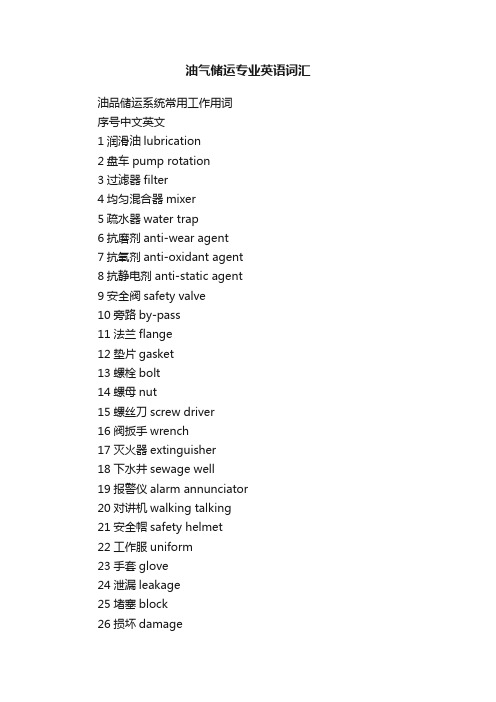
油气储运专业英语词汇油品储运系统常用工作用词序号中文英文1润滑油lubrication2盘车pump rotation3过滤器filter4均匀混合器mixer5疏水器water trap6抗磨剂anti-wear agent7抗氧剂anti-oxidant agent8抗静电剂anti-static agent9安全阀safety valve10旁路by-pass11法兰flange12垫片gasket13螺栓bolt14螺母nut15螺丝刀screw driver16阀扳手wrench17灭火器extinguisher18下水井sewage well19报警仪alarm annunciator20对讲机walking talking21安全帽safety helmet22工作服uniform23手套glove24泄漏leakage25堵塞block26损坏damage27汽油gasoline28航煤jet fuel29柴油diesel30液化气LPG( liquefied petroleum gas ) 31燃料油fuel oil 32液碱liquid alkaline33废水waste water34蒸汽steam35氨水ammonia36硫化氢sulfureted hydrogen37胶皮管rubber hose38开关switch39灯lamp40冷却水cooling water41换热器heat exchanger42罐tank43机械密封mechanical seal44油杯oil cup45轴承bearing46轴承箱bearing case47抹布towel48拖布mop49铁锹spade50压力表pressure gauge51流量表flow meter52调节阀control valve53手电筒flashlight54油尺dipping meter55电机motor56油壶oil kettle57油桶oil barrel58库房warehouse59修理repair60正常normal61浮盘float roof62吹扫purge63分液罐dewatering drum64工艺流程flow path65盲板block plate66突沸sudden boiling67串岗off post68空气呼吸器air breather69密度density70馏程distillation71真空度vacuum72盘根packing73润滑脂grease74碱渣caustic sludge75补偿器compensator76循环circulation77防护罩safety case78组份cut79样品sample80分析单analysing sheet81化验室laboratory82调度dispatch83闪点flash point84蒸汽压vapor pressure85合格证certification86辛烷值octane number87离心泵centrifugal pump 88螺杆泵screw pump89静电static electricity 90通风ventilation 91摩擦friction92搅拌churn up93火炬flare94水封罐water seal tank95溢流over flow96避雷器lightning arrester97呼吸阀respiratory valve98透光孔light hole99附件adjunct100阻火器flame arrester101加热盘管heat coil102伴热线heat trace103罐容capacity104试水膏water paste105防爆工具explosive proof tools。
本科专业中英文对照
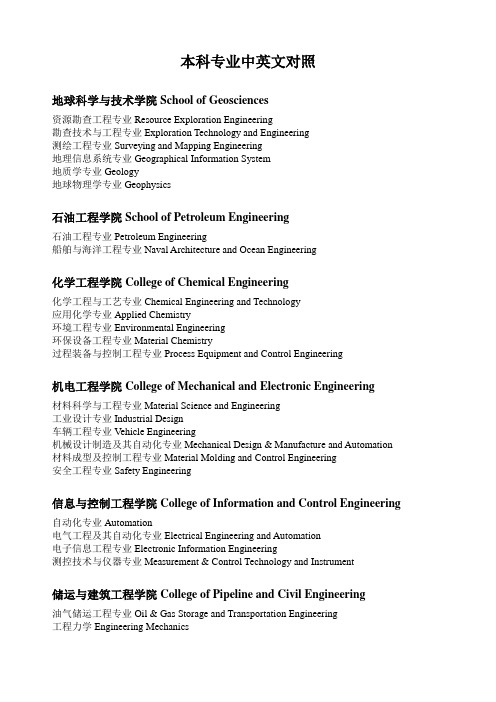
本科专业中英文对照地球科学与技术学院School of Geosciences资源勘查工程专业Resource Exploration Engineering勘查技术与工程专业Exploration Technology and Engineering测绘工程专业Surveying and Mapping Engineering地理信息系统专业Geographical Information System地质学专业Geology地球物理学专业Geophysics石油工程学院School of Petroleum Engineering石油工程专业Petroleum Engineering船舶与海洋工程专业Naval Architecture and Ocean Engineering化学工程学院College of Chemical Engineering化学工程与工艺专业Chemical Engineering and Technology应用化学专业Applied Chemistry环境工程专业Environmental Engineering环保设备工程专业Material Chemistry过程装备与控制工程专业Process Equipment and Control Engineering机电工程学院College of Mechanical and Electronic Engineering材料科学与工程专业Material Science and Engineering工业设计专业Industrial Design车辆工程专业Vehicle Engineering机械设计制造及其自动化专业Mechanical Design & Manufacture and Automation 材料成型及控制工程专业Material Molding and Control Engineering安全工程专业Safety Engineering信息与控制工程学院College of Information and Control Engineering自动化专业Automation电气工程及其自动化专业Electrical Engineering and Automation电子信息工程专业Electronic Information Engineering测控技术与仪器专业Measurement & Control Technology and Instrument储运与建筑工程学院College of Pipeline and Civil Engineering油气储运工程专业Oil & Gas Storage and Transportation Engineering工程力学Engineering Mechanics土木工程专业Civil Engineering热能与动力工程专业Thermal Power and Power Engineering建筑环境与设备工程专业Architectural Environment and Equipment Engineering建筑学专业Architecture计算机与通信工程学院College of Computer and Communication Engineering计算机科学与技术专业Computer Science and Technology软件工程专业Software Engineering通信工程专业Communication Engineering经济管理学院Schlool of Economics and Management工程管理专业Engineering Management信息管理与信息系统专业Information Management and Information System会计学专业Accounting财务管理专业Financial Management国际经济与贸易专业International Economy and Trade行政管理专业Administration Management经济学专业Economics市场营销专业Marketing and Sales公共事业管理专业Public Utility Management电子商务专业Electronic Commerce工商管理专业Business Administration理学院College of Science应用物理学专业Applied Physics材料物理专业Materials Physics材料化学专业Materials Chemistry信息与计算科学专业Information and Computing Science数学与应用数学专业Mathematics光信息科学与技术专业Optical Information Science and Technology文学院College of Arts英语专业English Language and Literature俄语专业Russian Language and Literature音乐学专业Musicology法学专业Science of Law艺术设计专业Art Design汉语言文学专业Chinese Language and Literature。
中国石油大学(华东)全日制专业学位专业目录最新版

限招理工科类毕业生;
同等学力考生必须同时符合以下条件:
①通过国家英语四级考试,其成绩在500分以上;②在核心期刊上以第一作者发表过所报专业学术论文,获得省部级以上本专业领域的科技进步奖,排名在前5名以内;③修过所报专业本科的6门以上主干课程;④不得跨专业报考。
01软件项目管理
02软件开发技术
03数字媒体与信息处理
04嵌入式系统开发技术
10
①101政治
②204英语二
③301数学一
④408计算机学科专业基础综合
复试专业课:计算机专业综合(含数据库系统、高级语言编程(C与C++)
同等学力加试:
①离散数学
②编译原理
430109电子与通信工程
01信号检测与处理
02计算机应用技术
03无线通信系统与技术
10
①101政治
②204英语二
③302数学二
④834通信原理
复试专业课:通信电子线路或数据结构
复试时考查动手能力测试(上机编程)
同等学力考生不得跨专业报考。
同等学力加试:
①信号与系统
②计算机网络原理
008
经济管理学院
460100MBA
01能源企业战略与管理
02国际石油贸易
03公司财务与会计
③302数学二
④827自动控制理论或828信号与系统或826电路
复试专业课:微机原理
006
储运与建筑工程学院
力工程
01石油化工设备
02热能工程
03多项流动与传热
04动力工程与管理
5
①101政治
- 1、下载文档前请自行甄别文档内容的完整性,平台不提供额外的编辑、内容补充、找答案等附加服务。
- 2、"仅部分预览"的文档,不可在线预览部分如存在完整性等问题,可反馈申请退款(可完整预览的文档不适用该条件!)。
- 3、如文档侵犯您的权益,请联系客服反馈,我们会尽快为您处理(人工客服工作时间:9:00-18:30)。
储运专业英语一、英译汉单词翻译CH1.Oil and Gas Fields 油气田1.1An Inroduction to oil and gas productiong油气生产介绍1.1.1gas processging气体加工1.1.2oil processing原油加工1.1.3water processing水处理1.1.4sand treatment砂处理1.1.5auxiliary equipment辅助设备1.2Brief description of crude oil surface treatment原油地面处理简介1.2.1 separators分离器1.2.2 oil treating原油处理1.2.3 heater-treaters加热处理器1.2.4 free water knockouts(FWKOs)游离水脱除器1.2.5vertical treaters立式处理器1.2.6 stabilization and sweetening of crude oil原油的稳定和脱酸1.2.7 storage tanks储罐1.3Treating oil field emulsions油田乳状液的处理1.3.1 theory of emulsions乳状液理论1.3.2 the major reasons for dehydrating crude oil原油脱水的主要原因1.3.3 treating methods处理方法1.3.4 some common terms一些常用术语1.4Overview of gas-handling facilities气体处理设备概论1.5Trays and packing塔板和填料1.5.1trays塔板1.5.1.1 sieve trays筛板1.5.1.2 valve trays 阀板1.5.1.3 bubble cap trays泡罩塔板1.5.1.4 high capacity/high efficiency trays高处理量/高效塔板1.5.1.5 bubble cap trays vs. valve trays泡罩塔板与阀板的比较1.5.1.6 tray efficiency and tower height塔板效率和塔高1.5.2 packing填料1.5.2.1 random packing随机填料1.5.2.2 stripping service规整填料1.6Gas sweetening气体脱酸1.6.1 gas sweetening processes气体脱硫工艺1.6.2amine processes胺工艺1.6.3 physical solvent processes物理溶剂工艺1.6.4direct conversion of H2S to sulfur H2S直接转换为硫磺1.6.5 gas permeation气体渗透1.7Dehydration of natural gas天然气脱水1.7.1 hydrates水合物1.7.2 dehydratoin of natural gas天然气脱水1.7.2.1 dew-point depression露点降1.7.2.2 liquid-desiccant dehydrators液体干燥剂脱水器1.8Hydrocarbon recovery and condensate stabilization烃回收和凝液稳定1.8.1hydrocarbon recovery processes烃回收工艺1.8.2absorber and stripper units吸收塔和气提装置1.8.3 condensate stabilization凝液稳定CH2 Pipelines管道2.1 types of pipelines管道类型2.1.1 oil pipelines输油管道2.1.1.1 flowlines出油管2.1.1.2 gathering lines集油管道2.1.1.3crude trunk lines原油干线管道2.1.2 gas pipelines输气管道2.1.2.1gas gathering集气管道2.1.2.2gas transmission输气干线2.1.3 products pipelines成品油管道2.2 other pipelines其他管道2.2.1two-phase pipelines两相流管道2.2.2LNG pipelines液化天然气管道2.2.3 CO2 pipelines CO2管道2.2.4 coal slurry pipelines煤浆管道2.3 rheology流变学2.3.1 what is rheology? 什么是流变学?2.3.2 viscosity黏度2.3.3 non-newtonian liquids非牛顿流体2.3.4 high pour and high viscosity高倾点和高粘度2.4 line pipes管道用管2.4.1 specifications规范2.4.2 steel pipe钢管2.4.3 other types of pipe其他类型的管子2.5 pumps and pump stations泵和泵站2.5.1 investment distributions投资分配2.5.2 pump stations泵站2.5.2.1 the number of pump stations泵站数2.5.2.2 station equipment泵站设备2.5.3 pumps泵2.5.3.1 centrifugal pumps容积泵2.5.4 types of station operation泵站操作类型2.5.4.1 put and take operation罐到罐操作2.5.4.2 float tank operation旁接罐操作2.5.4.3 tight line operation密闭操作2.6 compressors压缩机2.6.1 reciprocating compressors往复式压缩机2.6.2 centrifugal compressors离心压缩机2.6.3 compression ratio压缩比2.6.4 capacity and horsepower流量和功率2.6.5 other considerations其他考虑因素2.7 gas turbines燃气透平2.7.1 types of gas turbines燃气透平类型2.7.2 operation操作2.8 pipeline pigging管道清管2.8.1 pigging 清管2.8.2 example of pigging operatings清管操作的例子2.8.3 launching and receiving发送和接收2.9 pipe coating管子覆盖层2.9.1 exterior corrosion coating外防腐覆盖层2.9.2 concrete coating混凝土加重层2.10 inspection and rehabilitation检查和修复2.10.1 inspecion检查2.10.2 in-line tools管内检查器2.10.3 rehabilitation修复2.10.3.1 external corrosion外腐蚀2.10.3.2 trans alaska pipeline repair横贯阿拉斯加管道的修理CH3 storage facilities储存设施3.1 storage储存3.1.1 crude storage原油储存3.1.2 natural gas liquids天然气凝析油3.1.3 natural gas天然气储存3.1.4LNG 液化天然气3.2 tand classification罐的分类3.2.1 tank classification储罐分类3.2.1.1 atmospheric tanks常压罐3.2.1.2 low-pressure tanks低压罐3.2.1.3 pressure vessels (high-pressure tanks)压力容器(高压罐)3.2.2 major tank components储罐主要部件3.2.2.1 fixed-foof tanks固定顶储罐3.2.2.2 floating-roof tanks浮顶罐3.2.2.3 tank bottoms罐底3.3 floating roofs浮顶3.3.1 external floating roofs外浮顶3.3.1.1 roof types顶的类型3.3.1.2 support legs支柱3.3.1.3 vents通风3.3.1.4 drainage排水3.3.1.5 wind girders抗风圈3.3.2 internal floating roofs内浮顶3.3.2.1 steel roofs钢顶3.3.2.2 aluminum roofs铝顶3.4 rim seals边缘密封3.4.1 external floating-roof seals外浮顶密封3.4.1.1 mechanical shoe seals机械滑板密封3.4.1.2 resilint toroid seals弹性环密封3.4.1.3 flexible wiper seals柔性刷密封3.4.1.4 weather shield风雨罩3.4.2 internal floating-roof seals内浮顶密封3.5 tank emissions and venting储罐发散物和通风3.5.1 mechanisms of evaporation losses蒸发损耗机理3.5.1.1 fixed-roof tanks固定顶储罐3.5.2 tank type and emissions储罐类型和发散3.5.2.1 fixed-roof tanks固定顶罐3.5.2.2 external floating-roof tanks外浮顶罐3.5.2.3 internal floating-roof tanks内浮顶罐3.5.3PV valves压力真空阀3.5.3.1 general概要3.5.3.2 how the PV valve works PV阀的工作3.5.4 emergency venting 应急泄压3.6 tank foundations储罐基础3.6.1 introduction to tank foundations储罐基础介绍3.6.1.1 preliminary studies初步研究3.6.1.2 soil investigations土壤研究3.6.2 imprtant elements to consider in foundation design基础设计中考虑的重要因素3.6.2.1 foundation elevation基础标高3.6.2.2 drainage排水3.6.2.3 oil sand under tank bottom罐底下的油砂3.6.3 tank foundation types储罐基础类型3.6.3.1 concrete ringwall foundations混凝土圈座基础3.6.3.2 crushed-srone ringwall foundations碎石圈座基础3.6.3.3compacted soil foundations夯土基础3.6.3.4 slab foundations平板基础3.6.3.5 pile-supported foundations桩柱支撑基础3.7 fire prevention and foam system防火和泡沫系统3.7.1 foam fire fighting systems泡沫灭火系统3.7.1.1 fluidity流动性3.7.1.2 expansion膨胀性3.7.1.3drainage rate吸水率3.7.2 foam making devices泡沫发生装置3.8 oil storage in rock caverns在岩洞内储存石油3.8.1 storage at 1 atmosphere在大气压下储存3.8.2 cavern design and constrution岩洞设计及建造3.8.3 general operation and maintenance操作和维护3.8.3.1 pumps泵3.8.3.2 heating加热3.8.3.3 sludge 沉积物3.8.3.4 level control and volume measurement液位控制和体积测量3.8.4 advantages of rock cavern storage岩洞储存的优点CH4 construcion建设4.1 land pipeline construction陆上管道建设4.1.1 construction classification建设分类4.1.2 land pipeline construction陆上管道建设4.2 pipeline installation and road/river crossing管道安装和管道/河流穿越4.2.1 installaton安装4.2.2 road/river crossings道路/河流的穿越4.2.3 testing试压4.2.4 drying and cleaning干燥和清管4.2.5 station construction站的建设4.3 offshore pipeline construction海洋管道建设4.3.1 conventional lay barge常规铺管船4.3.2 reel barge卷筒船4.3.3 vertical pipelaying垂直铺管4.4 pull methods and tie-in牵引法和碰固定口连接4.4.1 pull methods牵引法4.4.2 tie-in碰固定口连接4.5 welding techniques and equipment焊接技术和设备4.5.1 welding processes焊接工艺4.5.2 welding procedures and equipment焊接程序及设备4.5.2.1 weld passes焊道4.5.2.2 manual welding手工焊接4.5.2.3 automatic welding自动焊4.5.2.4 preparation for welding焊接准备4.5.2.5 inspection and testing检查与试验4.5.2.6 weld defects焊接缺陷4.5.3 other joining methods其他连接方法CH5 corrosion腐蚀5.1 cause of underground corrosion地下腐蚀的原因5.1.1 electrolytic corrosion电解腐蚀5.1.2 galvanic corrosion电池腐蚀5.1.2.1 dissimilar metals不同金属5.1.2.2 dissimilar environments不同环境5.2 cathodic protection fundamentals阴极保护的基本原理5.2.1 corrosion and corrosion control腐蚀和服饰控制5.2.1.1 electrically insulating anode area from cathodic area阳极区和阴极区的电绝缘5.2.1.2 electrically insulating anode or cathode from the elecrolyte阳极或阴极与电解质的电绝缘5.2.1.3 treatment of electrolyte电解质处理5.2.1.4 use of nonmetallic materials非金属材料的应用5.2.2 cathodic protection阴极保护5.2.2.1 galvanic cathodic protection systems原电池阴极保护系统5.2.2.2 impressed current systems外加电流系统5.2.3 design and criteria for cathodic protection阴极保护的设计和准则5.3 pipeline corrosion管道腐蚀5.3.1 estimating the corrosion risk腐蚀风险评估5.3.1.1 intrinsic corrosiveness of the soil土壤固有的腐蚀性5.3.1.2 electrolytic effects电解作用5.3.2 corrosion protection腐蚀防护5.3.2.1 insulating coatings绝缘涂层5.3.2.2 cathodic protection阴极保护5.3.2.3 protection against electrolysis电解的保护5.4 tank corrosion储罐腐蚀5.4.1 descriptive nature of tank corrosion储罐腐蚀性质描述5.4.1.1 atmospheric corrosion大气腐蚀5.4.1.2 product side corrosion油品接触面腐蚀5.4.1.3 bottom corrosion罐底腐蚀5.4.1.4 vapor space corrosion蒸气空间腐蚀5.4.1.5 interface corrosion界面腐蚀5.4.1.6 bottom underside corrosion罐底下侧腐蚀5.4.2 corrosion control and prevention腐蚀控制及防护5.4.3 specific storage tank corrosion service problems专用储罐的腐蚀问题(石油产品)5.4.3.1 crude oil tanks原油储罐5.4.3.2 refined hydrocarbon storage tanks成品油储罐5.4.4 corrosion prevention with linings用涂层防腐5.4.4.1 basic types of lining涂层的基本类型5.4.4.2 surface preparation表面预处理5.4.4.3 precleaning预清洗5.4.4.4 abrasive blasting喷磨处理5.4.4.5 other surface preparation methods其他表面预处理方法5.4.5 corrosion prevention with cathodic protection用阴极保护防止腐蚀5.4.5.1 cathodic protection阴极保护5.4.5.2 polarization极化5.4.5.3 electrical potential measurement电位测量5.4.5.4 current requirements电流需求5.4.5.5 internal versus external cathodic protection内部与外部阴极保护CH6 metering installations计量装置6.1 metering gases气体计量6.1.1differential pressure meters差压流量计6.1.2 positive-displacement meters(PD)容积式流量计(PD)6.1.3 turbine-type meters涡轮流量计6.1.4 mass-flow meters质量流量计6.2metering of liquids液体计量6.2.1 types of meters in use在用流量计类型6.2.2 positive-displacement meters容积式流量计6.2.3 turbine meters涡轮流量计6.2.4 meter calibration流量计标定6.3 BTU measurement热值测量。
